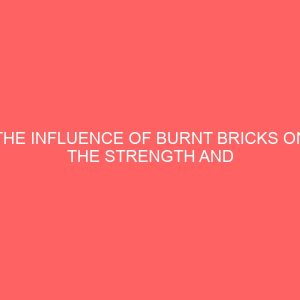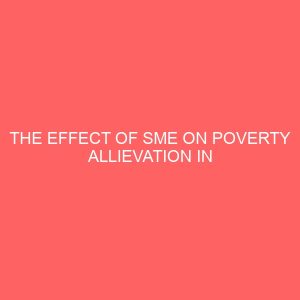Description
ABSTRACT
This work involved onsite observation of the production process; determination of physical properties and chemical composition of the soil sample used for production of Makurdi burnt bricks MBB. A total of 22 brick specimens, of the MBB was examined in the laboratory for compressive strength, water absorption and abrasion resistance. The results reveal the soil sample as a true laterite having a SilicaSesquioxide ratio of 1.01, Silica content of 42.95 and clay content of 27.38 and total clay silt content of 30.78. The Atterbergs limit test gave the liquid limit as 36.79; plastic limit, 26.11and plastic index, 10.68. Compressive strength was 3.46 N/mm2 and 11.75 N/mm2 for Samples A and B respectively; Average water absorption for Sample B 16.49 was double that of Sample A 8.58 while the Abrasion resistance ability of Sample B 33.67 was four times better than Sample A 9.32.
CHAPTER ONE
INTRODUCTION
Most construction and building are with bricks. Since many centuries brick making has been practiced by human beings. Presently, bricks are easily made by using machines using new technologies.
Concrete is produced by mixing cement, sand, coarse aggregate and water to produce a material that can be molded into almost any shape. The major volume of concrete is filled with aggregate. Aggregate inclusion in concrete reduces its drying shrinkage and improves many other properties.
Aggregate is also the least expensive per weight unit, put it makes the most amount of the weight. It is costly to transport so local sources are needed, but due to geographical constraint this is not available at all places, therefore it necessitates finding other sources and alternatives from local sources.
In eastern and north eastern states of India and Bangladesh where natural rock deposits are scarce, burnt clay bricks are used as an alternative source of coarse aggregate. In these places of India brick aggregate are traditionally used as coarse aggregate. The use and performance of concrete made with broken brick as coarse aggregate are quite extensive and satisfactory for ordinary concrete. Clay and silt alongwith appropriate quantity of sand can be burnt in its natural form as is done in brickmaking and the product may be a source of coarse aggregate for concrete. Also in brickmaking, a large number of bricks are rejected due to nonconformity with the required specifications. One such major nonconformity is the distorted form of brick produced due to the uneven temperature control in the kiln. These rejected bricks can also be a potential source of coarse aggregate.
Akhtaruzzaman and Hasnat investigated the various engineering properties of concrete using crushed brick as coarse aggregate. Khaloo studied the properties of concrete using crushed clinker brick as coarse aggregate. In both the abovementioned studies, investigations were also done by comparing the properties of brick aggregate concrete with those for stone aggregate concrete. Rashid et al. investigated the properties of higher strength concrete with brick aggregate. On the other hand, studies were done by Mansur et al. comparing the properties of stone aggregate concrete with those of equivalent brick aggregate concrete obtained by replacing stone with an equal volume of crushed brick, everything else remaining the same.
Cachim studied the mechanical properties brick aggregate concrete by partial replacement of natural stone aggregate by brick aggregate and it was found that upto 15 replacement there is no reduction of strength. Debieb and Kenai showed that it is possible to produce concrete containing crushed bricks coarse and fine with characteristics similar to those of natural aggregate concrete provided that the percentage of brick aggregates is limited to 25 and 50 for the coarse and fine aggregate respectively.
Apart from strength parameter in ambient temperature Khalaf and DeVenny studied the thermal properties of brick aggregate concrete and it was found that brick aggregate concrete perform similar and even better than granite aggregate concrete in elevated temperature.
1.2. OBJECTIVE OF THE STUDY:
The main objective of this research work is on the analysis of the strength of burn bricks block and its water absorption level. At the end if the project, it is expected that the following objectives will be achieved.
To determine the percentage of water absorption of bricks
The strength of bricks as a building blocks will be known
The essence of using brick in building will be highlighted
The cost of production of the bricks will be known.
1.3. PURPOSE OF THE STUDY:
The purpose and aim behind the research of this project topic is to determine and analysis the strength and water absorption of burn bricks as compared to that of concrete. The knowledge of this will assist a construction engineer to make an accurate selection of building blocks to use in any construction that he wants to embark on. With this knowledge at hand, the mistakes of using the wrong building blocks for a job which in most cases leads to collapse will be avoided.








Reviews
There are no reviews yet.